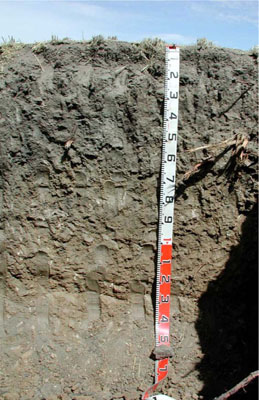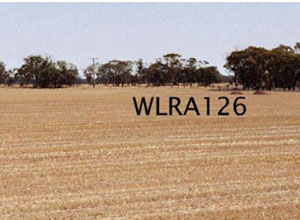WLRA126
|
| WLRA126 |  Epicalcareous-Endohypersodic, Self-mulching, Grey VETROSOL | |
|
Location | Borung Highway, Areegra, western Victoria | |||
|
Landform | Plain | |||
|
Geology | Quaternary Woorinen Formation: aeolian dune sand, calcareous clay | |||
|
Element | Flat | |||
|
Slope | 0% | |||
|
Aspect | – | |||
Horizon | Depth (cm) | Description | ||
Ap | 0–12 | Very dark grey (2.5Y3/1); fine sandy clay loam; weak fine subangular blocky structure; rough ped fabric; very weak consistence when dry; abundant fine roots; highly calcareous; pH 9.0; smooth and clear boundary to: | ||
B1 | 12–25 | Dark grey (2.5Y4/1); light clay (heavy); strong fine to medium angular blocky, parting to fine to very fine subangular blocky and prismatic structure; rough ped fabric; firm consistence when dry, subplastic; many fine roots; very highly calcareous; pH 9.5; smooth and gradual boundary to: | ||
B21 | 25–55 | Greyish brown (2.5Y5/2) with common medium (2.5Y4/1) faint mottles; medium clay; strong coarse polyhedral, parting to very fine to fine angular blocky and prismatic structure; smooth ped fabric; very firm consistence when dry, subplastic; common slickenside (20-80 mm) cutans; very few manganiferous nodules (<2 mm) with calcareous nodules and flecks (2-6 mm); fine roots common; very highly calcareous; pH 9.5; smooth and gradual boundary to: | ||
B22 | 55–80 | Greyish brown (2.5Y5/3) with common medium (2.5Y4/1) faint mottles; medium heavy clay; moderate fine to very fine polyhedral structure; rough ped fabric; very firm consistence when dry, subplastic; common slickenside (50--100 mm) cutans; very highly calcareous; pH 9.5; smooth and gradual boundary to: | ||
B23 | 80–110 | Greyish brown (2.5Y5/3) with common (2.5Y5/1) faint mottles; medium clay (heavy); weak fine polyhedral structure; rough ped fabric; strong consistence when dry, subplastic; very few fine manganiferous nodules and medium calcareous nodules and flecks; very highly calcareous; pH 9.5; smooth and gradual boundary to: | ||
B3 | 110–135+ | Greyish brown (2.5Y5/3); light clay; massive (structureless); earthy ped fabric; firm consistence when moderately moist; very few fine manganiferous and calcareous flecks; highly calcareous; pH 9.5. | ||
| Management Considerations | ||||
| ||||
Horizon | Depth (cm) | pH (water) | pH (CaCl2) | EC dS/m | Exchangeable Cations cmol-/kg | Coarse Sand % | Fine Sand % | Silt % | Clay % | |||
Ca | Mg | K | Na | |||||||||
A1 | 0–12 | 8.3 | 7.9 | 0.22 | 34 | 4.2 | 2.8 | 0.16 | 20.3 | 19.6 | 19.5 | 32 |
B1 | 12–25 | 8.6 | 8.1 | 0.26 | 25 | 6.1 | 2.1 | 1 | 15.8 | 17.6 | 8.5 | 46 |
B21 | 25–55 | 9 | 8.3 | 0.27 | 21 | 12 | 1.7 | 3.9 | 13.8 | 18.4 | 6.5 | 55 |
B22 | 55–80 | 9.4 | 8.6 | 0.41 | 13 | 13 | 1.6 | 5.9 | 14.4 | 10.5 | 5.5 | 53.5 |
B23 | 80–110 | 9.6 | 9 | 0.6 | 11 | 16 | 1.9 | 8.3 | ||||
B3 | 110–135+ | 9.6 | 9.1 | 0.95 | 9.5 | 15 | 2.2 | 11 | 12.1 | 10.9 | 6 | 59.5 |



